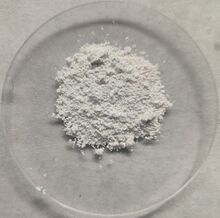Chemistry:Bismuth subcarbonate

| |
| Names | |
|---|---|
| Other names
bismuth oxycarbonate, bismuthyl carbonate,
bismutite | |
| Identifiers | |
3D model (JSmol)
|
|
PubChem CID
|
|
| UNII | |
| |
| Properties | |
| (BiO)2(CO3) | |
| Molar mass | 509.9685 g/mol |
| Appearance | fine white to pale yellow-white powder |
| Density | 6.86 g/cm3 |
| Boiling point | decomposes |
| insoluble | |
| Hazards | |
| NFPA 704 (fire diamond) | |
Except where otherwise noted, data are given for materials in their standard state (at 25 °C [77 °F], 100 kPa). | |
| Infobox references | |
Bismuth subcarbonate (BiO)2CO3, sometimes written Bi2O2(CO3) is a chemical compound of bismuth containing both oxide and carbonate anions. Bismuth is in the +3 oxidation state. Bismuth subcarbonate occurs naturally as the mineral bismutite. Its structure[1] consists of Bi–O layers and CO3 layers and is related to kettnerite, CaBi(CO3)OF. It is light-sensitive.
Uses
It is highly radiopaque and for example is used as a filler in radiopaque catheters which can be seen by x-ray.[2] In modern medicine, bismuth subcarbonate has been made into nanotube arrays that exhibit antibacterial properties.[3] It is also used in fireworks[4] to make Dragon's eggs. It is a constituent of milk of bismuth which was a popular digestive tract panacea in the 1930s.[5]
Safety
Bismuth subcarbonate may be harmful if swallowed. It may irritate the respiratory and gastrointestinal tract.
Synthesis
Bismuth subcarbonate can be attained from the reaction between bismuth nanoparticles and the atmospheric carbon dioxide (CO2) dissolved in water.[6] Bismuth subcarbonate has the tendency to form nanoplates, but it can be also obtained as small round nanospheres (with controlled size) when it is grown in the presence of halloysite nanotubes.[7] The high pH and high temperature of the aqueous solution helps to reduce the time of synthesis. It is readily formed on the surface of undoped bismuth oxide (β-Bi2O3 and γ-Bi2O3) nanoparticles even when they are not suspended in water.[8]
Structure
Bismuth subcarbonate has a structure with a tetragonal unit cell. Layers of (BiO)n positively charged, and carbonate anion (CO32-) are surrounding both sides of the (BiO)+n layer to compensate the charge. Usually, The (BiO)'n layer grows perpendicular to the b axis.[9]
References
- ↑ Joel D. Grice (2002). "A Solution to the crystal structures of bismutite and beyerite". The Canadian Mineralogist 40 (2): 693–698. doi:10.2113/gscanmin.40.2.693.
- ↑ Flexible, highly radiopaque plastic material catheter - Patent 5300048
- ↑ "Fabrication of bismuth subcarbonate nanotube arrays from bismuth citrate". Chem. Commun. (21): 2265–2267. 2006. doi:10.1039/b601764a. PMID 16718324.
- ↑ How To Make Cheaper Crackling Firework Stars (Dragon Eggs) With Bismuth Subcarbonate
- ↑ Park & Davis Co catalog entry for milk of bismuth
- ↑ "Transformation of Bismuth and β-Bi2O3 Nanoparticles into (BiO)2CO3 and (BiO)4(OH)2CO3 by Capturing CO2: The Role of Halloysite Nanotubes and "Sunlight" on the Crystal Shape and Size". Cryst. Growth Des. 18 (8): 4334–4346. 2018. doi:10.1021/acs.cgd.8b00177.
- ↑ "Transformation of Bismuth and β-Bi2O3 Nanoparticles into (BiO)2CO3 and (BiO)4(OH)2CO3 by Capturing CO2: The Role of Halloysite Nanotubes and "Sunlight" on the Crystal Shape and Size". Cryst. Growth Des. 18 (8): 4334–4346. 2018. doi:10.1021/acs.cgd.8b00177.
- ↑ "Bismuth Oxide Nanoparticles Partially Substituted with EuIII, MnIV, and SiIV: Structural, Spectroscopic, and Optical Findings". Inorg. Chem. 56 (6): 3394–3403. 2017. doi:10.1021/acs.inorgchem.6b02923. PMID 28252972.
- ↑ "Transformation of Bismuth and β-Bi2O3 Nanoparticles into (BiO)2CO3 and (BiO)4(OH)2CO3 by Capturing CO2: The Role of Halloysite Nanotubes and "Sunlight" on the Crystal Shape and Size". Cryst. Growth Des. 18 (8): 4334–4346. 2018. doi:10.1021/acs.cgd.8b00177.
External links
| H2CO3 | He | ||||||||||||||||
| Li2CO3, LiHCO3 |
BeCO3 | B | C | (NH4)2CO3, NH4HCO3 |
O | F | Ne | ||||||||||
| Na2CO3, NaHCO3, Na3H(CO3)2 |
MgCO3, Mg(HCO3)2 |
Al2(CO3)3 | Si | P | S | Cl | Ar | ||||||||||
| K2CO3, KHCO3 |
CaCO3, Ca(HCO3)2 |
Sc | Ti | V | Cr | MnCO3 | FeCO3 | CoCO3 | NiCO3 | CuCO3 | ZnCO3 | Ga | Ge | As | Se | Br | Kr |
| Rb2CO3 | SrCO3 | Y | Zr | Nb | Mo | Tc | Ru | Rh | Pd | Ag2CO3 | CdCO3 | In | Sn | Sb | Te | I | Xe |
| Cs2CO3, CsHCO3 |
BaCO3 | Hf | Ta | W | Re | Os | Ir | Pt | Au | Hg | Tl2CO3 | PbCO3 | (BiO)2CO3 | Po | At | Rn | |
| Fr | Ra | Rf | Db | Sg | Bh | Hs | Mt | Ds | Rg | Cn | Nh | Fl | Mc | Lv | Ts | Og | |
| ↓ | |||||||||||||||||
| La2(CO3)3 | Ce2(CO3)3 | Pr | Nd | Pm | Sm | Eu | Gd | Tb | Dy | Ho | Er | Tm | Yb | Lu | |||
| Ac | Th | Pa | UO2CO3 | Np | Pu | Am | Cm | Bk | Cf | Es | Fm | Md | No | Lr | |||
 |

